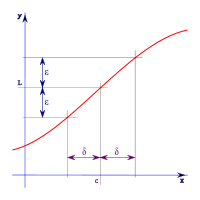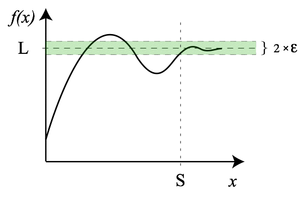- Limit (mathematics)
-
This is an overview of the idea of a limit in mathematics. For specific uses of a limit, see limit of a sequence and limit of a function.
In mathematics, the concept of a "limit" is used to describe the value that a function or sequence "approaches" as the input or index approaches some value.[1] The concept of limit allows mathematicians to define a new point from a Cauchy sequence of previously defined points within a complete metric space.[2] Limits are essential to calculus (and mathematical analysis in general) and are used to define continuity, derivatives, and integrals.
The concept of a limit of a sequence is further generalized to the concept of a limit of a topological net, and is closely related to limit and direct limit in category theory.
In formulas, limit is usually abbreviated as lim as in lim(an) = a or represented by the right arrow (→) as in an → a.
Contents
Limit of a function
Main article: Limit of a functionSuppose f(x) is a real-valued function and c is a real number. The expression
means that f(x) can be made to be as close to L as desired by making x sufficiently close to c. In that case, it can be stated that "the limit of f of x, as x approaches c, is L". Note that this statement can be true even if f(c) ≠ L. Indeed, the function f(x) need not even be defined at c.
For example, if
then f(1) is not defined (see division by zero), yet as x moved arbitrarily close to 1, f(x) correspondingly approaches 2:
f(0.9) f(0.99) f(0.999) f(1.0) f(1.001) f(1.01) f(1.1) 1.900 1.990 1.999 ⇒ undef ⇐ 2.001 2.010 2.100 Thus, f(x) can be made arbitrarily close to the limit of 2 just by making x sufficiently close to 1.
Augustin-Louis Cauchy in 1821,[3] followed by Karl Weierstrass, formalized the definition of the limit of a function into what became known as the (ε, δ)-definition of limit in the 19th century. The definition uses ε (the lowercase Greek letter epsilon) to represent a small positive number, so that "f(x) becomes arbitrarily close to L" means that f(x) lies in the interval (L - ε, L + ε), which can also be written using absolute value as |f(x) - L| < ε.[3] The statement "x approaches c" then indicates that a positive number δ (the lowercase greek letter delta) exists within either (c - δ, c) or (c, c + δ), which can be expressed with 0 < |x - c| < δ. The first inequality means that the distance between x and c is more than 0 and that x ≠ c, while the second indicates that x is within distance δ of c.[3]
In addition to limits at finite values, functions can also have limits at infinity. For example, consider
- f(100) = 1.9900
- f(1000) = 1.9990
- f(10000) = 1.99990
As x becomes extremely large, the value of f(x) approaches 2, and the value of f(x) can be made as close to 2 as one could wish just by picking x sufficiently large. In this case, the limit of f(x) as x approaches infinity is 2. In mathematical notation,
Limit of a sequence
Main article: Limit of a sequenceConsider the following sequence: 1.79, 1.799, 1.7999,... It can be observed that the numbers are "approaching" 1.8, the limit of the sequence.
Formally, suppose x1, x2, ... is a sequence of real numbers. It can be stated that the real number L is the limit of this sequence, namely:
to mean
- For every real number ε > 0, there exists a natural number n0 such that for all n > n0, |xn − L| < ε.
Intuitively, this means that eventually all elements of the sequence get as close as needed to the limit, since the absolute value |xn − L| is the distance between xn and L. Not every sequence has a limit; if it does, it is called convergent, and if it does not, it is divergent. One can show that a convergent sequence has only one limit.
The limit of a sequence and the limit of a function are closely related. On one hand, the limit of a sequence is simply the limit at infinity of a function defined on natural numbers. On the other hand, a limit of a function f at x, if it exists, is the same as the limit of the sequence f(an) where an is any arbitrary sequence whose limit is x, and where an is never equal to x. Note that one such sequence would be x + 1/n.
Convergence and fixed point
A formal definition of convergence can be stated as follows. Suppose pn as n goes from 0 to
 is a sequence that converges to a fixed point p, with
is a sequence that converges to a fixed point p, with  for all n. If positive constants λ and α exist with
for all n. If positive constants λ and α exist withthen pn as n goes from 0 to
 converges to p of order α, with asymptotic error constant λ
converges to p of order α, with asymptotic error constant λGiven a function f(x) = x with a fixed point p, there is a nice checklist for checking the convergence of p.
- 1) First check that p is indeed a fixed point:
- f(p) = p
- 2) Check for linear convergence. Start by finding
 . If....
. If....

then there is linear convergence 
series diverges 
then there is at least linear convergence and maybe something better, the expression should be checked for quadratic convergence - 3) If it is found that there is something better than linear the expression should be checked for quadratic convergence. Start by finding
 If....
If....

then there is quadratic convergence provided that  is continuous
is continuous
then there is something even better than quadratic convergence  does not exist
does not existthen there is convergence that is better than linear but still not quadratic Topological net
Main article: Net (topology)All of the above notions of limit can be unified and generalized to arbitrary topological spaces by introducing topological nets and defining their limits.
An alternative is the concept of limit for filters on topological spaces.
See also
- Limit of a sequence
- Rate of convergence: the rate at which a convergent sequence approaches its limit
- Limit of a function
- One-sided limit: either of the two limits of functions of a real variable x, as x approaches a point from above or below
- List of limits: list of limits for common functions
- Squeeze theorem: finds a limit of a function via comparison with two other functions
- Limit in category theory
- Asymptotic analysis: a method of describing limiting behavior
- Big O notation: used to describe the limiting behavior of a function when the argument tends towards a particular value or infinity
Notes
- ^ Stewart, James (2008). Calculus: Early Transcendentals (6th ed.). Brooks/Cole. ISBN 0-495-01166-5.
- ^ Rudin, Walter (1976). Principles of Mathematical Analysis. McGraw-Hill. ISBN 0-07-054235-X.
- ^ a b c Larson, Ron; Edwards, Bruce H. (2010). Calculus of a single variable (Ninth ed.). Brooks/Cole, Cengage Learning. ISBN 9780547209982.
- ^ Numerical Analysis, 8th Edition, Burden and Faires, Section 2.4 Error Analysis for Iterative Methods
External links
- Weisstein, Eric W., "Limit" from MathWorld.
- Mathwords: Limit
Categories:- Limits (mathematics)
- Real analysis
- Asymptotic analysis
- Differential calculus
- General topology
Wikimedia Foundation. 2010.








